Adventure • 02/01/2023
8 Carry-On Luggage Rules You Should Know

Revivalist is a reader-supported endeavor and our posts may contain affiliate links. When you buy through links on our site, we may earn an affiliate commission.
Now that most countries have lifted COVID-19 restrictions, you might be itching to earn a new passport stamp. You once more have the freedom to explore your world.
However, you must still abide by certain rules or risk your vacation plans going south. Knowing how to pack your carry-on luggage prevents last-minute delays, letting you and your fellow passengers enjoy a happier journey. Who wants to be responsible for holdups caused by last-minute checked-baggage fees?
What can you take on the plane, and what should you leave at home or stow in your checked bag? Here are eight carry-on luggage rules you should know.
1. Size Matters
The first carry-on luggage rule you need to know is how big a bag you may use. There’s limited room in overhead bins, and airline staff must ensure adequate space for all customers.
In general, your bag must be smaller than 22 inches high by 14 inches wide and 9 inches thick. Most airlines don’t impose weight limits on carry-on luggage, although you must be able to lift it to the overhead bin by yourself.
Additionally, TSA rules limit carry-on luggage to one bag and one small personal item per customer. Those traveling with pets must count their companion as one or the other, depending on their carrier size. Pushing the limits means cutting other passengers short, so please behave courteously, keeping in mind how you would feel if you got shorted because somebody else bent the rules.
2. Liquid Concerns
Ever since 9/11, authorities in the United States have limited the amount of liquid you can carry on a plane. This rule includes most aerosols, gels and pastes. You can have no more than 3.4 ounces or 100 milliliters, so think carefully. Do you really need that tiny mouthwash when you can pickup another immediately after landing?
This rule extends to hand sanitizer. However, the authorities showed some mercy during COVID-19 by not placing any restrictions on antibacterial wipes. Therefore, a stash of these is a better option than a squeeze gel if you have other fluids filling up your quota.
3. Sharp Objects
The TSA has a mixed bag of rules governing sharp objects. In general, you’re better off leaving them in your checked luggage. Additionally, even permitted items must be sheathed, and agents reserve the right to refuse any object through the checkpoint if they determine it poses a security risk.
Knives and box cutters are no-gos, but you’re in luck if you’re a knitting “knut.” You can bring your favorite needles. Multitools are a bit trickier — authorities may permit them if the scissors are less than 4 inches long. Those with knives are prohibited.
4. Personal Safety Devices
If you’re a vulnerable individual traveling alone, it’s natural to want to bring protection with you. However, many of your devices need to go in checked luggage if authorities permit them at all.
For example, carry-on luggage rules prohibit bringing pepper spray or mace on a plane, but you can include one 4-ounce spray can in your checked luggage if it has a safety device to prevent accidental discharge.
Guns also belong in your checked bag. However, you must declare them at check-in and store them unloaded in a hard-sided, locking case. Please remember that taking a firearm into a foreign country without following their rules can result in criminal prosecution, so do your homework before you pack.
5. Vaping Devices
Here’s a carry-on luggage rule that flips the tables. While you may carry your vaping device in your carry-on luggage, many airlines prohibit them from checked bags because they generate heat. However, please don’t think you can kick back in your seat and puff.
You’ll have to keep your vices strictly under wraps until the plane lands. The same guidelines apply to most terminals, although you’ll have to check individual rules for designated smoking areas where you can relax with a drag.
6. Medications
What if you take a prescription medication like insulin or a biologic that requires refrigeration? Your best bet is to take a twofold approach. Contact your airline regarding their rules and your drug’s manufacturer.
Why take the second step? Although it’s a little-known secret, many brands like Humira have free travel kits they’ll provide to customers — if they ask. Not every drug manufacturer offers this perk, but you should take advantage if yours does.
7. Alcohol and Cannabis
What’s in that vape pen you stashed in your carry-on luggage? What about that vial of CBD oil you rub on your lower back during agonizingly long flights?
Fortunately, you’re okay with the latter as long as you remain within liquid quotas. Formulations with less than 0.3% THC make the cut, which includes many CBD preparations.
The line gets a little murkier with cannabis, regardless of whether you are a patient. While TSA officials state they don’t actively look for the plant, officers must report any item they find that violates the law. Since cannabis remains illegal at the federal level, you should leave it at home, even if you are a medical patient, or risk the whims of law enforcement officials and the judicial system.
Surprisingly, you can carry alcohol on a plane, even in your carry-on luggage, although it must remain within the liquid limit. However, you can’t drink it while on board.
Checked bags can contain bottles limited to five liters of 24% to 70% alcohol per volume per person. You may need a receipt to prove you purchased duty-free items within the past 48 hours, and all alcoholic beverages must be in their original, sealed containers.
8. Sporting Equipment
You can do considerable damage to the human body with a baseball bat, so officials require you to place such items in your checked bags. However, sporting equipment is a bit like sharp objects in terms of carry-on luggage rules — some pieces pass muster while others do not.
For example, you might think ice skates fall into the knives category, but TSA permits them in your carry-on luggage. You can also take your skateboard if it falls within the size requirements. In general, anything that you can use as a bludgeon, such as hockey sticks and golf clubs, needs to go in your checked luggage. You may have to pay an additional fee for bulky items like golf bags and surfboards.
Carry-On Luggage Rules You Should Know
Knowing the rules for carry-on luggage can streamline your trip. You’ll expedite the takeoff process when there are no conflicts about what you can stow in the overhead bin.
Review these eight carry-on luggage rules before you pack. You’ll have better peace of mind, allowing you to relax and enjoy your flight.
Subscribe to Our Weekly Newsletter
We would love to connect deeper with you!


